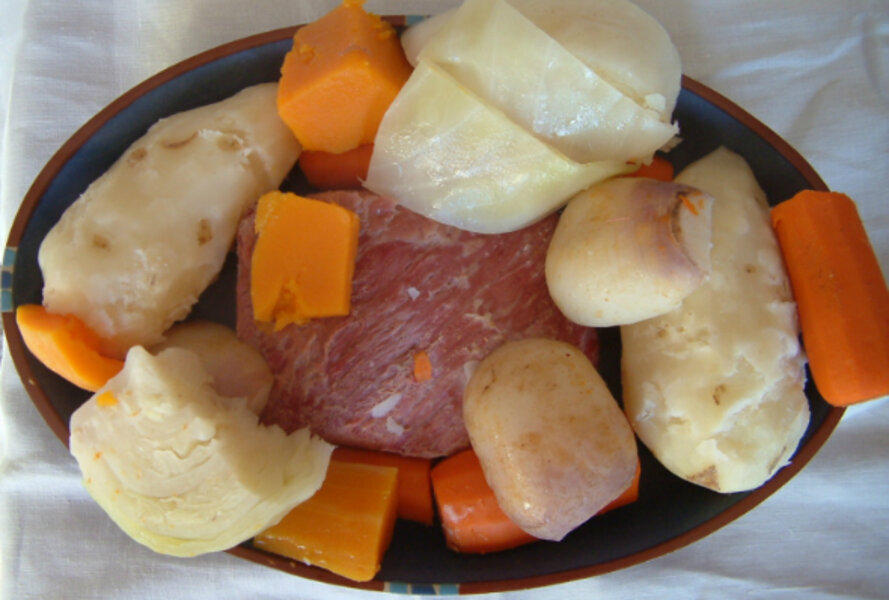New England boiled dinner
Loading...
Here in Boston, boiled corned beef is especially cherished by Irish Americans on St. Patrick’s Day. It’s even served every Thursday evening at Doyle’s Cafe, our local Irish pub in Jamaica Plain (movie stars and politicians love this place).
Say the words “boiled dinner” to most epicurians and you might be greeted with a grimaced face that seems to say, “Boiled? It sounds simply awful!”
In fact, boiled dinner is quite delicious. The corned beef is cooked until it melts in your mouth and the root vegetables are so tender they can be sliced with a spoon. It’s also so easy to prepare without much watching that it could be called the original slowcooker meal.
When considering this dish as a New England classic, it’s easy to see how the corned beef could have been put on to simmer early in the morning before church, and then finished up when everyone returned home for Sunday dinner.
New England boiled dinner was also a favorite dish of another famous Bostonian – Mary Baker Eddy, the founder of The Christian Science Monitor.
Her cook, Minnie Weygandt, took copious notes on what meals were served in the Eddy household to avoid repeating menus too often. But New England boiled dinner was a regular in the rotation. On April 15, 1900, she noted this dinner:
“One dinner which [Mrs. Eddy] liked so much that it almost seemed as if she hardly knew when to stop eating was boiled dinner. But that was not ordinary boiled dinner such as most of us are used to. The corned beef was put on at dawn to simmer in a great kettle. Then all kinds of vegetables were put in and this cooked and cooked until it was almost like jelly. Three Bartlett pears were added when they were to be had.
When this dish was brought to the table it was of such texture and consistency that it melted in the mouth. Custard pie was often served as dessert.
As it was quite a job to prepare and cook these boiled dinner just as Mrs. Eddy wanted them, I always saw that there was ample quantity on hand. The leftover cabbage was packed in a mold and sliced down and served cold, dressed with vinegar the next day. The vegetables and beets were made into what Mrs. Eddy called ‘flannel hash.’ She was very fond of these dishes, but the family somtimes got tired of them and fussed a bit when they saw a boiled dinner appear, thinking, I suppose, that there were going to get too much of a good thing.” (Weygandt reminiscences, p. 36-37)
When I set out to recreate New England boiled dinner, I had some trouble figuring out what “corned beef” looked like. I know you can buy corned beef hash in cans, but that’s not what I was after. The tattooed hipster store clerks at the community co-op where I shop had no clue either. I circled the store several times before I found it.
It is a huge piece of meat.
The package held about 4 pounds of brisket. I decided for my purposes, I would just make half the recipe. This also makes a good winter meal because it uses such a nice collection of root vegetables and squashes. You can swap out and add any variety of root vegetables to your liking.
I put the meat on to simmer and then got to work peeling and chopping the vegetables. Traditionally, carrots and potatoes you leave whole. And, you can leave the potato jackets on, it probably helps them to keep their form as they boil. My potatoes were naked, but they turned out fine.
The other interesting thing about this recipe is that there are no added spices or seasonings – you simply cook the vegetables in the salty broth of the meat.
Another tip: Remove the meat from your Dutch oven or large pot after it is done and keep it warm to make room for all of the vegetables as they cook in the pot. (Unless you have one of those giant over-the-fire kettles.) The recipe also says when serving to simply lay the meat on a large platter and arrange all the vegetables around it. Every morsel is so tender that you can scoop up what you want from the platter, the meat doesn’t need to be carved. I remember doing this as a child, since New England boiled dinner was one of my dad’s all-time favorite meals.
This communal approach isn’t a very “pretty” treatment to a dish that is quite homely to begin with. If you are trying to plate your meal in a way that looks attractive to your dinner guests, I suggest checking out New England boiled dinner on Simply Recipes. Elise does a nice job of styling an appetizing boiled dinner there.
Otherwise, just gather your friends ’round the table, lift your spoons, and dig in – after you say grace, of course.
New England Boiled Dinner
From “The American Heritage Cookbook”
Serves 6 to 8
4 to 5 pounds corned beef
6 carrots
6 medium potatoes
1 medium yellow turnip
1 small head green cabbage
1 small crookneck or butternut squash
Place beef in a large kettle and cover with cold water. Bring to a boil, then reduce heat, and simmer gently for 3 to 4 hours or until tender when pierced with a fork. While beef simmers, scrape carrots and leave whole; pare potatoes and leave them whole, too; pare turnip and cut in sixths; cut cabbage head in sixths; peel squash, remove seeds and membrane, and cut in large even chunks.
The trick to cooking a good boiled dinner is to have all the vegetables down at the same time. Carrots, potatoes, and turnips take about 30 to 35 minutes to cook. The cabbage and squash will cook in 15 to 20 minutes. As you drop each batch of vegetables into the liquid, increase the heat so the broth continues to bubble. to serve, place beef in the center of a large heated platter and surround it with all the vegetables. Traditional accompaniments are freshly cooked beets dressed with vinegar, and johnnycake, with apple pie for dessert.
This post was part of the First Saturday program at The Mary Baker Eddy Library, which sponsored a month-long look at 19th-century foodways.








